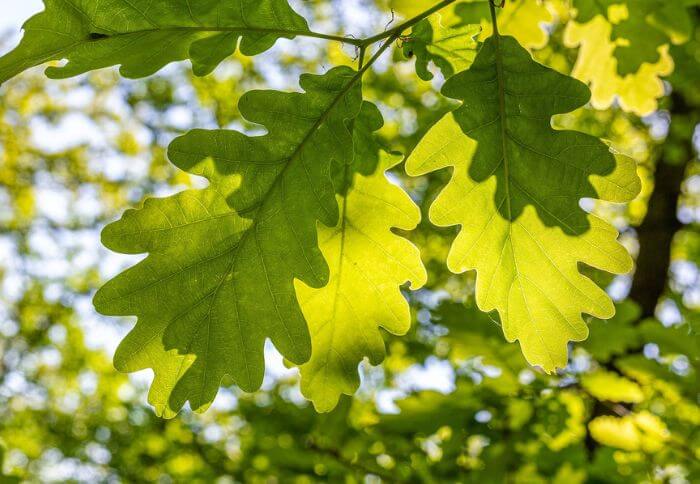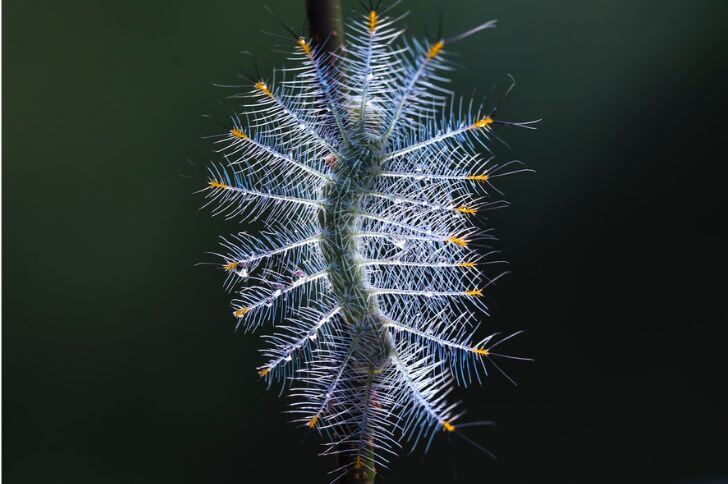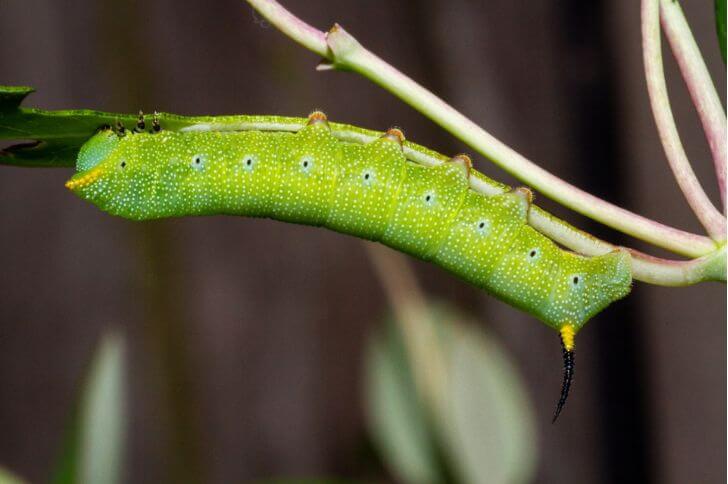What Do Gypsy Moths Eat? (9 Foods)
Gypsy moths, with their enchanting yet destructive nature, have long captivated the curiosity of scientists and nature enthusiasts alike.
These seemingly delicate creatures are known for their voracious appetites and remarkable ability to defoliate entire forests, leaving a path of devastation in their wake.
Originating from Europe and Asia, gypsy moths made an unintentional debut in the United States in the late 1860s and have since become a notorious invasive species.
Despite their negative impact on ecosystems, there is an undeniable allure to these elusive insects that has sparked extensive research and fascination among those seeking to understand the complex interplay between nature and human intervention
What do gypsy moths eat? (Favorite food)

The gypsy moth, known for its destructive feeding habits, has a voracious appetite for a variety of tree species. However, its all-time favorite food is oak leaves.
The caterpillars of the gypsy moth tend to feast predominantly on the tender young leaves of oak trees during their larval stage. This preference for oak leaves can be attributed to their nutritional value and relatively low levels of defensive chemicals compared to other tree species.
Other foods that gypsy moths consume
1. Apple
Gypsy moth caterpillars are known for their insatiable appetite, particularly for the leaves of apple trees. The damage caused by gypsy moth feeding can significantly impact apple orchards and lead to reduced fruit production.
However, innovative techniques such as pheromone traps and biological control methods are being employed to mitigate the impact of these destructive insects on apple crops.
2. Linden
In the world of gypsy moths, linden trees are a veritable feast for these voracious pests. The tender and succulent leaves of the linden tree provide ample nourishment for gypsy moth larvae, making them a prime target for infestation.
In fact, linden trees are often heavily targeted by gypsy moths due to their high nutritional value and abundant foliage.
Interestingly, the preference of gypsy moths for linden trees can have significant implications for local ecosystems.
As these invasive insects defoliate linden trees, it can lead to stress and even mortality of these important plants.
3. Willows
Willows, often known for their graceful appearance and exquisite branches, provide an irresistible feast for gypsy moth caterpillars.
These pests are notorious for their voracious appetites, and willow trees are no exception to their unforgiving nibbling.
The delicate leaves of the willow tree act as a prime source of sustenance for the gypsy moth caterpillars, sustaining them as they grow and mature.
Unfortunate as it may be for the cherished willow tree, this relationship between gypsy moths and willows unveils an intriguing dynamic in nature’s web of interconnectedness.
Gypsy moths find solace in feasting upon the tender leaves of the willow tree during their early stages of development.
This unique preference sheds light on the coevolutionary strategies at play between insects and plant life – allowing readers to appreciate the intricacies of ecological relationships.
4. Boxelders
Boxelder trees, also known as Acer negundo, are a common host plant for gypsy moth larvae. These fast-growing trees provide ample nourishment for the voracious appetites of gypsy moth caterpillars.
Boxelders are particularly susceptible to defoliation from gypsy moths due to their tender foliage and smooth bark, making them an ideal target for these destructive pests.
Gypsy moth caterpillars feed on the leaves of boxelder trees, stripping them bare and leaving behind a trail of destruction.
This can have detrimental effects on the overall health and vitality of boxelder trees, potentially leading to stunted growth and increased vulnerability to diseases and other pests.
The presence of gypsy moths can significantly impact the ecosystem dynamics, disrupting the balance between predator and prey and altering the biodiversity within forested areas where boxelders grow.
5. Hawthorn
Hawthorn trees, also known as thornapples or maytrees, offer a feast for gypsy moths and play a vital role in their life cycle.
These deciduous trees not only provide sustenance for the moth larvae but also serve as a nesting ground for the adult moths.
The tender leaves and young shoots of hawthorn trees are particularly favored by gypsy moth caterpillars, making these trees an essential component of their diet.
However, the consumption of hawthorn leaves by gypsy moths can lead to defoliation and significant damage to these iconic trees.
One fascinating aspect of the relationship between gypsy moths and hawthorn trees is how it has shaped the evolutionary adaptation of both species.
For example, some hawthorn trees have developed mechanisms to produce chemicals or compounds that deter gypsy moth larvae from feeding on their leaves.
This natural defense mechanism indicates an ongoing battle between the two, with each side continually adapting in response to the other’s strategies.
Understanding this interplay underscores the intricate web of ecological interactions that contribute to the survival and proliferation of various species within ecosystems.
6. Sweet gum
Sweet gum trees, also known as Liquidambar styraciflua, are a favorite food source for gypsy moth caterpillars.
These voracious insects feed on the leaves of sweet gum trees, often causing defoliation and significant damage to the trees.
The sweet gum’s distinctive star-shaped leaves are particularly appealing to gypsy moths, making these trees a prime target for infestations.
Interestingly, the chemical composition of sweet gum leaves may play a role in attracting gypsy moths. The high levels of tannins and other compounds in the leaves could contribute to their palatability for these insects.
This suggests that sweet gum trees have developed unique defense mechanisms that attract specific herbivores rather than deterring them.
Understanding the interaction between gypsy moths and sweet gum trees sheds light on the complex relationship between plants and insect herbivores, offering valuable insights into ecological dynamics and plant defenses.
7. Paper birch
The beautiful and distinctive paper birch, also known as Betula papyrifera, is a sight to behold in North American forests.
Its iconic white bark peels away in thin layers, revealing the smooth, creamy wood underneath. This unique characteristic of the paper birch not only makes it visually stunning but also serves practical purposes for Native American cultures who used its bark for shelter and canoes.
Interestingly, while paper birch trees may be appealing to humans with their striking appearance, they are also a favored food source for gypsy moths.
These voracious pests can quickly defoliate a stand of paper birch trees, causing significant damage to the ecosystem.
As a result, understanding the impact of gypsy moths on paper birch populations is crucial for preserving the health and diversity of our forests.
8. Basswood
Basswood trees, also known as American linden trees, play a crucial role in the diet of gypsy moths.
These large, deciduous trees produce an abundance of nutritious leaves that are a favorite food source for gypsy moth caterpillars.
The tender, broad leaves of the basswood provide a hearty meal for these voracious insects, supporting their growth and development throughout their lifecycle.
Despite being a favored food source for gypsy moths, basswood has evolved fascinating defense mechanisms to combat insect herbivory.
The tree produces various secondary metabolites and chemical compounds that deter or even harm feeding insects. Interestingly, this complex interplay between basswood and gypsy moths showcases the intricate balance between plant defense mechanisms and insect adaptation.
As researchers delve deeper into this dynamic relationship, they uncover insights into the interconnectedness of ecosystems and the adaptability of both plants and insects in response to environmental pressures.
9. Oak

Oaks, as majestic and enduring trees, are an integral part of ecosystems worldwide. These resilient giants support a diverse array of wildlife, including the voracious gypsy moth caterpillars.
As herbivorous pests, these caterpillars eagerly feast on the oak leaves, stripping them bare and potentially harming the tree’s health.
The intricate relationship between gypsy moths and oaks offers a glimpse into the complex interplay of nature – highlighting how these trees play a crucial role in sustaining both flora and fauna.
How do gypsy moths consume food
Gypsy moths are voracious eaters, with their consumption habits being a sight to behold. These caterpillars have an insatiable appetite for foliage and can defoliate entire trees in a matter of days.
Their feeding frenzy consists of chewing through leaves, leaving behind skeletal remains of once lush greenery.
Upon closer inspection, it’s fascinating to observe how these tiny creatures use their strong mandibles to devour foliage with remarkable efficiency.
Moreover, the gypsy moth’s feeding behavior is not restricted to a single type of plant or tree. They have been known to feast on a wide variety of vegetation, from oak and aspen trees to shrubs and garden plants.
This diverse palate allows them to adapt and thrive in various environments, making them formidable pests in forestry and agricultural settings.
Understanding the intricate details of how gypsy moths consume food sheds light on the impact they can have on ecosystems and the measures necessary to mitigate their destructive influence.
Related read: Where do moth go during the day?
Can gypsy moths kill oak trees?
Gypsy moths are voracious eaters and can pose a significant threat to oak trees. The larvae of gypsy moths feed on the leaves of oak trees, stripping them bare and weakening the tree’s ability to photosynthesize and produce food.
If left unchecked, a severe infestation of gypsy moth larvae can ultimately lead to the death of an oak tree.
The impact of gypsy moths on oak trees goes beyond just defoliation. The stress caused by the loss of leaves can make the tree more susceptible to other pests and diseases, further compromising its health.
In addition, repeated defoliation from gypsy moth larvae year after year can significantly reduce the oak tree’s ability to store nutrients, leading to stunted growth and potential long-term decline.
While gypsy moths may not immediately kill an oak tree with just one infestation, their cumulative effect over time can seriously threaten the health and longevity of these majestic forest giants.
It is essential for landowners and forest managers to monitor for signs of gypsy moth activity and take action to mitigate their impact before irreversible damage occurs.
Are gypsy moths invasive?
Gypsy moths are indeed considered invasive species, as they have the potential to cause significant damage to forests and trees.
Native to Europe and Asia, these moths were accidentally introduced to North America in the late 19th century, and their population has since spread rapidly across the continent.
Their voracious appetite for a wide variety of tree species, including oak, poplar, and birch, poses a major threat to the delicate balance of ecosystems.
These invasive insects can defoliate entire forests within weeks, leaving behind a landscape devoid of foliage.
This not only weakens trees and makes them more susceptible to disease, but also disrupts food chains and deprives other native species of crucial habitats.
Efforts to control gypsy moth populations include using pesticides or introducing natural predators such as parasitic wasps. However, the challenge remains substantial due to the moths’ resilience and adaptability in diverse environments.
With their destructive impact on vegetation and ecosystems, gypsy moths underscore the importance of vigilance in managing invasive species.
Which animals eat gypsy moths
Birds such as bluebirds, chickadees, and woodpeckers feast on gypsy moth larvae, helping to control their population.
Additionally, small mammals like mice and shrews actively hunt for gypsy moth caterpillars as a part of their diet.
Interestingly, some insects also play a role in keeping the gypsy moth population in check. Parasitic wasps lay their eggs inside gypsy moth caterpillars, eventually killing them as the wasp larvae develop.
Furthermore, certain species of spiders have been observed preying on adult gypsy moths when they emerge from their cocoons.
This intricate web of predators demonstrates the interconnectedness of ecosystems and showcases how nature continuously seeks balance.
source:

Passionate animal enthusiast and skilled writer with a flair for captivating storytelling. With over five years of experience, I have crafted engaging content that sheds light on the fascinating world of animals.
Through my articles, blog posts, and social media campaigns, I strive to raise awareness about conservation efforts and promote a deeper understanding of the natural world.





